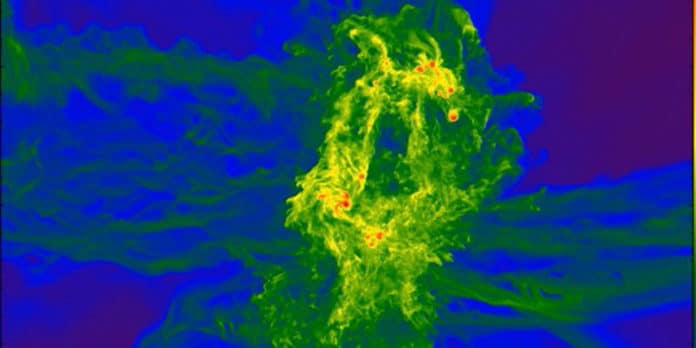Up to ~40 supermassive black holes have been observed, which are believed to power the optically bright quasars; however, how these quasars formes less than a billion years after the Big Bang is still one of the outstanding problems in astrophysics.
Now, a team of astrophysicists has solved this mystery. They found that the first quasars naturally formed in the early universe’s violent, turbulent conditions of rare gas reservoirs.
Supercomputer simulations in past studies suggested that early quasars were formed at the junctions of rare, cold, and powerful gas streams. There were only a dozen of these in a large volume of space, a billion light-years, yet they had to be 100,000 solar masses when they were born. Today’s black holes are typically only 10 to 100 solar masses and emerge when big stars run out of fuel and collapse.
It has been speculated that the stars with solar masses 10,000 – 100,00 formed in the early universe but only in exotic, finely-tuned environments like strong ultraviolet backgrounds or supersonic flows between gas and dark matter had no resemblance to the turbulent clouds in which the first quasars formed.
The team of experts led by Dr. Daniel Whalen from the University of Portsmouth said, “We think of these stars as a bit like dinosaurs on earth, they were enormous and primitive. And they had short lives, living for just a quarter of a million years before collapsing to black holes.”
“This discovery is fascinating because it has overturned 20 years of thought on the origin of the first supermassive black holes in the universe.”
“We find supermassive black holes at the centers of most massive galaxies today, which can be millions or billions of times the sun’s mass. But in 2003, we began finding quasars – highly luminous, actively-accreting supermassive black holes like cosmic lighthouses in the early universe – that existed less than a billion years after the Big Bang. And no one understood how they formed by such early times.”
“We think of these stars as a bit like dinosaurs on earth, they were enormous and primitive. And they had short lives, living for just a quarter of a million years before collapsing to black holes.”
“Our supercomputer models returned to very early times and found that the cold, dense streams of gas capable of growing a billion solar-mass black holes in just a few hundred million years created their supermassive stars without need for unusual environments. The cold streams drove turbulence in the cloud that prevented normal stars from forming until the cloud became so massive that it collapsed catastrophically under its weight, forming two gigantic primordial stars – one of 30,000 solar masses and another of 40,000.”
“Consequently, the only primordial clouds that could form a quasar just after cosmic dawn -when the first stars in the universe formed – also conveniently created their massive seeds. This simple, beautiful result explains not only the origin of the first quasars but also their demographics – their numbers at early times.”
“The first supermassive black holes were simply a natural consequence of structure formation in cold dark matter cosmologies – children of the cosmic web.”
Journal Reference:
- Latif, M.A., Whalen, D.J., Khochfar, S. et al. Turbulent cold flows gave birth to the first quasars. Nature 607, 48–51 (2022). DOI: 10.1038/s41586-022-04813-y
